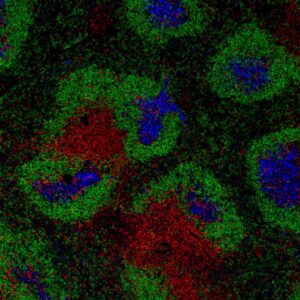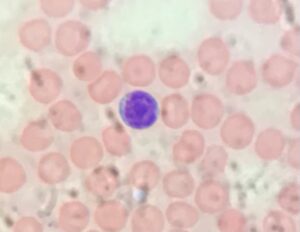I’m almost 100% sure that you have received a message today. Maybe an email, an SMS or a text on any of your social media accounts. We are all being bombarded with messages every single day, telling us to do this, and that. The funny thing is… it is not that different inside of our cells. Our cells are receiving messages all the time. These messages are transformed into “actions” which together allow our cells to adapt to many different situations. And that is when mRNAs come in!
I have to admit that it took me a long time to have the courage to write and publish this post. Although I have received many personal messages asking me about this subject, I just knew that there are many scientists with way more expertise in this topic than me. But the ImmunoThoughts Blog is also a personal space for me to grow, and without trying, that would be impossible. So, in this post I’m doing my best to explain to you about mRNAs and their role on vaccines, I hope you like it!
A room inside of a room
Before we start talking about mRNA, let’s start from the beginning. As I mentioned in previous posts, our bodies are made of cells, and to make it simple, let’s divide our cells into two compartments. First, we have the nucleus in which we find our DNA. This area is surrounded by a membrane that protects our precious genetic material from the rest of the components of our cells.
Second, we have “the rest”. This area is called the cytoplasm (as always, not get too caught up in the hard words, let’s aim for concept). In this simplistic view, anything that is not inside of our nucleus is present in the cytoplasm. This location is also surrounded by a membrane which will give the shape of our cells. Easy, right?
I don’t know about you, but there are a few … who am I kidding?… there are many things in science that really blow my mind. Our DNA is one of them.
A single book with all the recipes
Think about this. Every single cell in your body has the same genetic material (DNA). Which you can think of as a book, containing all the possible recipes to make the different proteins in your body.
It is easy for us to imagine how the cells in our hearts are different from the cells in our lungs. They all need to perform different tasks, but they technically have the same “book of information” (which again, is protected inside the nucleus).
How Stefanie? Well, I asked myself the same question when I first started to think about this. One of the reasons why our cells can be so different while possessing the same DNA is because each of them will only make a few proteins.
And here is where the “two locations” in our cells become essential. Let’s for a second pretend that in your house you have a recipe book stuck in the bedroom. The book won’t leave this location no matter how hard you try. So, in order for you to cook your meal, you write the recipe in a post-it and bring it to the kitchen, where you will have all the ingredients and the machines necessary to make your delicious meal (which in my case, something containing chocolate would be ideal).
A similar process is happening inside our cells… The book of all the recipes (the DNA) is stuck inside a room (the nucleus), and in order for our cells to make the recipe (a protein), it needs to write the information in a little post-it (an mRNA) which will then travel into the kitchen (the cytoplasm) where we have all the ingredients and machinery necessary to make our meal are located!
The mRNA (short for messenger RNA) is therefore a molecule that has the ability to send information from the nucleus to the cytoplasm to make our proteins!
mRNA Vaccines
And that is when the Eureka moment comes in. Scientists were very clever and used this “natural technology” to develop a vaccine. Although, I will make a post explaining a little bit further this concept, here are a few insights.
An mRNA vaccine contains a message which allows our cells to make a small portion of a protein present on the SARS-CoV-2 virus. Once we get the vaccine, the mRNA will enter inside our cells (in the cytoplasm) and the information will be used to make this small viral protein.
As you know, our immune system is very good at differentiating between natural vs foreign proteins. Therefore, this small foreign viral protein will be used to “teach” our immune system about the SARS-CoV-2 virus. Our immune system uses this cue to get ready, and be better at fighting the virus if we ever get infected with it in the future! Isn’t that amazing?
Crucial things to keep in mind
Talking to my friends, I compiled a few questions which can be easily answered now that you know a little bit more about the function and location of mRNAs.
First, mRNAs are very unstable. This means that the information to make the virus protein won’t stay in your cells for long. Which is perfect! Our cells will make a few proteins, enough to “train” our immune system, and that is it. No more! You won’t be making this protein forever, since the mRNA will degrade very fast.
Second, in our bodies we have the tools to make mRNA from DNA, however, we DON’T have the machinery to make DNA from mRNA. This means that the mRNA you will receive, WON’T change your DNA! You can also think about location. The DNA will stay in the nucleus and the mRNA you will receive will stay in the cytoplasm! Therefore, you don’t need to worry about the vaccine changing your genetic material.
Lastly, the mRNA vaccine won’t make you infected with SARS-CoV-2. Why? Well, the mRNA vaccine has a message to make only a portion of a protein present on the virus. The SARS-CoV-2 virus (like all other viruses) has many different proteins. It is like saying that having a small post-it with one recipe allows you to make many different recipes. No, that won’t happen.
Together, these are only a few reasons why exploring this “natural technology” is so clever!
I’m very fortunate to have already received the first dose of an mRNA vaccine, and I hope that your turn has, or will come very soon!
Thanks for stopping by, stay safe and go get that mRNA!
From your immunologist – in training,
Stefanie Valbon



